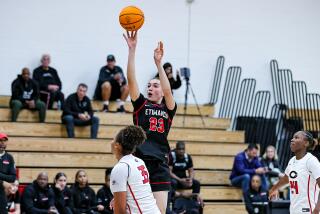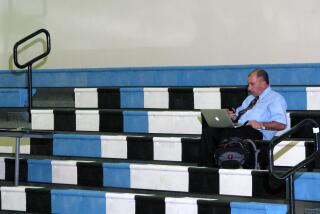New helmet technology could help in spotting potential concussions

- Share via
A hard hit rattles a football player’s helmet, prompting vibrations in an athletic trainer’s pocket. If the trainer wasn’t already, he (or she) starts watching the player for signs of a concussion.
The wireless alert system from helmet maker Riddell is one of several technologies aimed at spotting potentially concussion-causing head impacts. But getting players and parents to try them remains a challenge.
Westlake Village Westlake High purchased 25 sensors this summer and offered them to its 120 players for $150 on a first-come, first-served basis. At least one parent, worried about huge demand, rushed to get her order in. But the hurry was unneeded. Only 20 players bought sensors.
“My feeling is, this is your child, and if my child sustained a hit large enough to possibly sustain a concussion, I would want someone to at least look at them,” said Scott Blatt, Westlake’s head athletic trainer. “In the society we live in, the knowledge is there but parents, I don’t know — it confused me.”
To be sure, the effort was a trial. Four California high schools and eight others across the country used the product, which is now aggressively being pitched to all high schools for next fall.
Blatt told parents about the sensor during a preseason meeting before he had seen it, and he said his lack of expertise might have left some parents uninterested.
Still, Blatt said, parents worried about sons being pulled from games and missing playing time. Several said they dropped the sensor topic after their sons declined to wear one.
“It was a real short conversation,” said Dennis Klifman, father of senior defensive end Christopher. “I asked my son if he wanted to use it, and he said no.”
Thousand Oaks Mayor Pro Tem Andy Fox said he would have bought one if his stepson Andre Baccellia wanted one.
“I’m a proponent of all the means available to ensure the safety of a player,” Fox said. “The use of technology in combination with the human element — observation and testing — that’s probably the best and safest route.”
Paul Sper said his son Colton, a senior wide receiver, didn’t absorb enough big hits to warrant a sensor.
“For us, it wasn’t an issue because there’s no repetitiveness of that kind or anything at his position,” Paul Sper said, adding that he considered the system “fairly expensive.”
Cathedral Catholic High, a San Diego private school, took a different approach than Westlake. Cathedral delayed some field equipment purchases and instead bought 24 sensors. The devices were installed for free in the helmets of varsity starters.
The Riddell InSite system gains data from five sensors sitting on a plastic-like, paper-thin lining placed on top of helmet padding. The sensors measure linear and rotational acceleration as well as the duration and location of a hit. A computer chip in the helmet transfers data to a hand-held alert monitor — typically carried by the trainer — via a low-power signal similar to Bluetooth.
An alert is issued when a formula based on data from more than 2 million hits determines that an impact fits into the top 1% of all hits. The system also warns when someone suffers a significant number of smaller impacts during a week. The algorithm can be tweaked based on position and whether the player is in high school or college.
When a Westlake High defender was penalized for a helmet-to-helmet hit during a playoff game last month, assistant athletic trainer Luke Snyder pulled out the “extra set of eyes” from the right front pocket of his shorts. He didn’t think the monitor, resembling a cellphone from the 1990s, had vibrated, but he wanted to double-check.
Alerts were issued at least once every game and about 30 times during the course of the season, Blatt and Snyder said. About half the time, trainers knew an alert was coming.
The alert lists the jersey number and name of the player. The trainer looks for wobbling motions that suggest the player is a bit woozy. If nothing is visually apparent, the trainer waits for a play stoppage to pull the player aside and assess his memory, balance and cranial nerve response.
The player gets asked whether he can recall the big hit. His eyes must follow the trainer’s finger. He is told to puff his cheeks and stick out his tongue. His arms and shoulders are tugged on. His neck is prodded. In most cases, a player closes the sequence with “I’m good.” Westlake pulled a player after an alert three times during the season, including twice when a trainer missed the hit.
Junior wide receiver and defensive back Jesse Cuccia generated several alerts. His dad, Westlake wrestling coach John Cuccia, said his son sometimes drops his chin when tackling. He made Jesse wear a sensor to gather irrefutable evidence about his tackling technique.
“We can tell him repeatedly, but now he can see it,” John Cuccia said. “He can’t deny it.”
Jesse eventually began to limit head shots, his dad and trainers said.
“He didn’t want to wear it because he was worried about it interrupting his play too much, but we told him he doesn’t have a choice,” John Cuccia said.
Freshman linebacker Brock Baldwin’s mom, Dena, bought a sensor after he suffered a concussion in a September game against Whittier La Serna. Though the cause was unclear, Dena speculated that dehydration and his hard-hitting style were the cause.
Brock threw up on the team bus ride back home and spent two weeks experiencing dizziness, resting and swallowing Tylenol. Dena Baldwin sought the sensor as assurance that any issue could be spotted early. It went off four times the remainder of the season, but sideline tests never revealed concussion symptoms.
“You don’t really think about it until you go through your son having a concussion,” she said. “I have had three boys, and they have had broken bones and all sorts of injuries, but when you’re dealing with your brain, that’s not something you can put a cast on and be on your way.”
Laura Ho, a pediatric nurse and wife of a fire captain, was among the first in line to purchase the sensor, which also costs $10 annually for reconditioning. Based on what she and her husband see at work, she called it a wise investment in their son Shane, a sophomore running back and safety.
“I know teenagers won’t come out to the sideline and say check me out,” she said.
Teammates teased Shane at first, slapping his helmet to activate the sensor, Laura Ho said. Ultimately, she said, Shane liked the extra guardian.
“I was kind of astonished by how few parents signed up,” she said. “I just thought it was a lack of knowledge on these parents and putting too much weight on an activity.”
Riddell’s system is not the only protection system on the market; competing products include helmet sensors from Cisco Systems and skullcap sensors from Reebok.
Next fall, Blatt said he would like as many as 80 players to wear sensors. He said schools should be able to find ways to fund the purchase for parents with financial concerns and reiterated that he found no negatives during the trial.
“Some players might have lost a play or two, but the advantages can be lifetime things, whether it’s noticing a big hit I didn’t or helping the kid spearing with his head,” Blatt said. “You probably won’t be able to buy a helmet without this technology in five years.”
Twitter: @peard33
More to Read
Go beyond the scoreboard
Get the latest on L.A.'s teams in the daily Sports Report newsletter.
You may occasionally receive promotional content from the Los Angeles Times.











